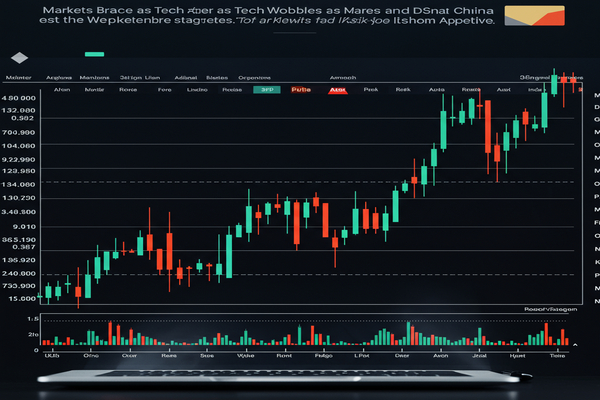
Market preview: Global stocks face a test as tech profit taking meets an unexpected China export drop that is weighing on sentiment now. U.S. tech weakness drove the biggest weekly loss for the sector in seven months, while China’s October export fall underlines how tariffs continue to shape trade flows. Short term, traders react to data and headlines with safe havens firming. Longer term, investors will watch whether this marks a pause in AI-led gains or a deeper cooling in global demand. The impact is felt across the U.S., Europe, Asia and emerging markets, and echoes earlier tariff frontloading episodes this year.
U.S. markets and tech names under pressure
AI exuberance cools, profit taking and governance headlines drive flows
U.S. equity futures open the session with a cautious tone after a week where tech-heavy indexes posted their largest weekly fall in seven months. Investors have grown uneasy about how far the rally in artificial intelligence and robotics stocks has run. That mood has driven rotation into safer assets such as government bonds and the yen.
High-profile corporate governance news added to the market’s mood. An activist shareholder vote approved a record pay package tied to an expanded vision for an electric vehicle maker that is pushing into AI and robotics. Tesla NASDAQ:TSLA drew attention as investors weighed pay norms and strategic direction for one of the sector’s most visible names.
Macro developments also matter. The U.S. political calendar and court decisions on domestic deployments of federal forces remain headline risks that can prompt intraday swings in risk assets. Meanwhile, proposed Pentagon procurement changes are likely to keep defense suppliers under watch as the defense procurement cycle accelerates.
China export shock and Asian market reaction
Tariff-driven frontloading reverses, export data exposes dependence on U.S. demand
China reported an unexpected fall in exports for October, the weakest since February by some measures. That decline follows months in which exporters frontloaded shipments to beat earlier tariff deadlines. The reversal highlights how much Chinese factory growth has relied on American consumers even as Beijing seeks to diversify markets.
Asian equities and exporters felt the impact quickly. Commodity flows and shipping activity will be monitored as traders parse whether this is a temporary pullback after frontloading or the start of a more persistent global demand slowdown. Currency markets reacted with increased volatility in regional FX and renewed interest in the Japanese yen as a safe haven.
Policymakers in Beijing are reported to be designing a new rare earths licensing regime that could speed shipments. Markets will watch whether policy tweaks ease supply chain frictions, but industry insiders caution that a full rollback of export controls appears unlikely at this stage.
Fixed income, FX and commodity dynamics
Bonds and the yen firm as equity risk falls, commodities track demand signals
With investors trimming equity exposure, demand for government debt has lifted, and yields moved lower in the past session. The yen strengthened, reflecting both safe haven demand and renewed caution on risk. In contrast, some commodity-linked currencies showed strain as China trade momentum weakened.
Oil and metals markets will watch Chinese flows closely. A tougher tone in export data could slow commodity imports, while any further policy signals from Beijing on industrial support would quickly reshape expectations. Separately, geopolitical flashpoints and energy trade headlines remain watch points after a major commodity trader withdrew a proposal to buy foreign assets of a large Russian energy company following U.S. Treasury comments.
Emerging markets and geopolitics
Local shocks test spillovers to capitals and credit markets
Emerging markets are sensitive to the twin forces of a weaker demand outlook in China and a pullback in global risk appetite. Local equities and credit spreads may feel pressure if the October export drop proves to be a durable signal of slowing international demand. Traders will also parse country-specific developments, such as law enforcement and human rights stories that can prompt policy reactions and foreign investment scrutiny.
Geopolitical headlines continue to move pockets of markets. Reports that U.S. approvals carried arms sales to a Brazilian unit tied to a deadly operation have elevated scrutiny of defense exports. Separately, Middle East ceasefire proposals and regional security warnings from senior NATO members add to a list of macro and political inputs that can shift real rates, commodity prices and defensive sector flows.
What to watch during the session
Data, earnings cues and policy signals to set intraday direction
Traders will monitor fresh China trade data revisions, any follow up comments on rare earth policy, and U.S. session economic releases for signs of growth resilience or cooling. Tech sector earnings and corporate governance developments will continue to draw capital in and out of riskier stocks. Central bank commentary and short term moves in core government bond yields will also be important as investors reassess carry and safe haven demand.
In the short term, headline risk and data flow will drive volatility. Over a longer horizon, market participants will watch whether the recent AI-led gains consolidate or whether trade and demand signals prompt a broader reappraisal of global growth expectations. For now, markets appear to be repricing a higher premium for policy uncertainty and headline risk while seeking clearer signals from economic releases and corporate updates.












